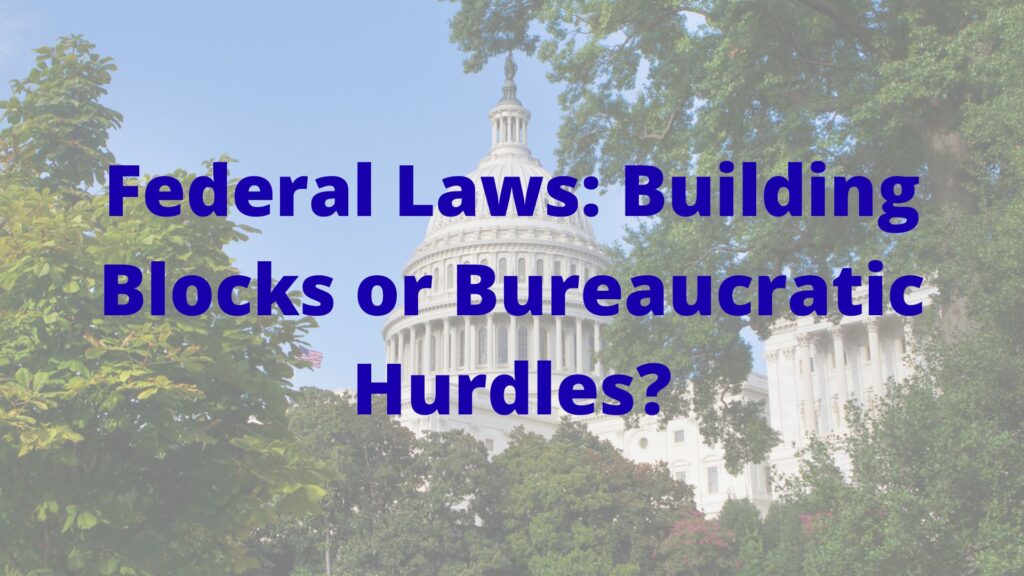
The construction industry, a vital engine of economic growth and infrastructure development, operates under a complex web of regulations. While state and local codes play a significant role, federal laws often cast a long shadow, profoundly impacting construction efforts and job creation. In diverse states like New York and Florida, these federal mandates present a fascinating dichotomy: they can both elevate standards and restrict progress.
The Federal Hand in Construction
From New York to Florida construction projects are constantly shaping the landscape. Behind every skyscraper, bridge, or residential development lies a foundation of planning, labor, and adherence to numerous legal frameworks. Among these, federal laws stand as powerful determinants, influencing everything from worker safety and wages to environmental protection and project timelines. Understanding their dual nature – their capacity to both enhance and impede – is crucial for anyone involved in or affected by the construction sector in these key states.
Federal Laws: Fortifying Foundations
Federal legislation often aims to establish a baseline of protection and fairness, which can ultimately improve the quality and sustainability of construction.
Worker Safety and Fair Wages (OSHA and Davis-Bacon Act): The Occupational Safety and Health Act (OSHA) is paramount. Its regulations mandate safe working conditions, provide guidelines for everything from fall protection to hazard communication, and require employers to keep detailed records of injuries and illnesses. In both New York and Florida, compliance with OSHA standards directly translates to safer job sites, reducing accidents and fatalities. While this requires investment in safety equipment and training, it safeguards the workforce and can ultimately reduce long-term costs associated with injuries and litigation. Similarly, the Davis-Bacon Act mandates that workers on federally funded or assisted construction projects exceeding $2,000 be paid no less than the local “prevailing wage” and fringe benefits. While sometimes criticized for increasing project costs, proponents argue it ensures fair compensation for skilled labor, preventing a race to the bottom in wages and promoting a stable, experienced workforce. This can be particularly impactful on large infrastructure projects in both states, guaranteeing a certain standard of living for construction workers.
Environmental Protection (Clean Water Act and Endangered Species Act): Federal environmental laws, such as the Clean Water Act (CWA) and the Endangered Species Act (ESA), impose significant requirements on construction projects. The CWA regulates the discharge of pollutants into U.S. waters, requiring permits for stormwater runoff from construction sites and mandating the implementation of Stormwater Pollution Prevention Plans (SWPPPs). This directly benefits New York’s and Florida’s precious waterways, protecting ecosystems and drinking water sources. While requiring additional planning and erosion control measures, these regulations help prevent long-term environmental damage and associated remediation costs. The ESA, meanwhile, protects threatened and endangered species and their habitats. For projects in ecologically sensitive areas of Florida, such as those near the Everglades or coastal regions, or even in certain parts of New York, this can necessitate extensive surveys, impact assessments, and potentially modifications to project designs or timelines. While this can add complexity and cost, it ensures biodiversity and the preservation of natural resources for future generations.
Federal Funding: Show me the Money
Federal funding serves as a monumental catalyst for construction projects across New York and Florida, providing essential financial lifelines that would otherwise be unattainable for many ambitious undertakings. Programs stemming from landmark legislation like the Bipartisan Infrastructure Law (BIL), also known as the Infrastructure Investment and Jobs Act (IIJA), allocate billions of dollars towards a wide array of infrastructure improvements. This includes substantial investments in repairing and upgrading highways, bridges, public transit systems, and water infrastructure, directly addressing aging infrastructure in New York City and expanding capacity in rapidly growing areas of Florida. These federal grants and loan programs enable states and local governments to initiate large-scale projects that foster economic development, create numerous jobs, and enhance the overall quality of life for residents.
Beyond merely providing capital, federal funding often encourages innovation and mandates higher standards for project execution. For instance, funding for resilient infrastructure projects helps New York rebuild stronger after severe weather events, while Florida benefits from investments in coastal protection and flood mitigation. Federal programs also prioritize projects that improve accessibility, reduce emissions, and promote sustainable practices, pushing both states towards greener and more equitable development. The infusion of federal dollars not only kickstarts critical construction, but also stimulates local economies by generating demand for materials, equipment, and skilled labor, thereby amplifying the positive impact on employment and business growth throughout the construction sector.
Federal Laws: Erecting Roadblocks?
Despite their beneficial intentions, federal laws can also present substantial challenges, potentially slowing down projects and increasing expenses.
Increased Costs and Bureaucracy: Compliance with numerous federal regulations often translates to higher project costs. The administrative burden of permits, detailed reporting, and adherence to specific standards can be significant. For instance, the rigorous environmental review processes under NEPA (National Environmental Policy Act), often triggered by federal funding or permits, can lead to lengthy delays and substantial expenses for studies and assessments. In New York, the interaction of federal funding with state-specific laws, such as the unique “Scaffold Law” (Labor Law Section 240) which imposes absolute liability on property owners and contractors for gravity-related injuries, has been cited as a major driver of soaring insurance costs, potentially adding millions to federally-funded projects. This creates a disincentive for development and can make New York one of the most expensive states to build in.
Project Delays and Resource Allocation: The extensive review and approval processes, particularly for environmental and historical preservation laws, can lead to significant project delays. For example, if a construction site is found to impact a protected species’ habitat, the project may be halted or require substantial redesign to mitigate the impact. This can tie up capital, extend project timelines, and cause ripple effects throughout the supply chain. In Florida, rapid development sometimes clashes with environmental concerns, and federal oversight can slow down projects in ecologically sensitive areas. While these delays are intended to ensure responsible development, they can be frustrating for developers and can impact job availability by pushing back project start dates.
Complexity and Enforcement Variations: Navigating the intricate landscape of federal regulations requires specialized knowledge and can be particularly challenging for smaller construction firms. The interpretation and enforcement of these laws can also vary, leading to uncertainty and potential legal disputes. Staying current with ever-evolving regulations requires ongoing training and resources, which can be a strain on businesses.
Finding the Balance
Federal laws in the construction industry in New York and Florida present a classic paradox. On one hand, they are indispensable for ensuring worker safety, promoting fair labor practices, and safeguarding the environment. These protections contribute to a more responsible, sustainable, and ethically sound construction sector. On the other hand, the layers of regulation, the potential for increased costs, and the often-lengthy approval processes can undoubtedly restrict the pace of development and add financial burdens.
The challenge for policymakers and industry stakeholders in both New York and Florida lies in finding a pragmatic balance. This involves streamlining regulatory processes where possible, providing clear guidance and support for compliance, and ensuring that federal mandates are implemented in a way that minimizes undue burdens without compromising their essential protective goals. Ultimately, fostering collaboration between federal agencies, state governments, and the construction industry itself will be key to harnessing the improving aspects of federal law while mitigating their restrictive tendencies, thereby building a more efficient, safe, and sustainable future for both states.
 John Caravella Esq., is a construction attorney and formerly practicing project architect at The Law Office of John Caravella, P.C., representing architects, engineers, contractors, subcontractors, and owners in all phases of contract preparation, litigation, and arbitration across New York and Florida. He also serves as an arbitrator to the American Arbitration Association Construction Industry Panel. Mr. Caravella can be reached by email: [email protected] or (631) 608-1346.
John Caravella Esq., is a construction attorney and formerly practicing project architect at The Law Office of John Caravella, P.C., representing architects, engineers, contractors, subcontractors, and owners in all phases of contract preparation, litigation, and arbitration across New York and Florida. He also serves as an arbitrator to the American Arbitration Association Construction Industry Panel. Mr. Caravella can be reached by email: [email protected] or (631) 608-1346.
The information provided on this website does not, and is not intended to, constitute legal advice; instead, all information, content, and materials available on this site are for general informational purposes only. Readers of this website should contact their attorney to obtain advice with respect to any particular legal matter. No reader, user, or browser of this site should act or refrain from acting on the basis of information on this site without first seeking legal advice from counsel in the relevant jurisdiction. Only your individual attorney can provide assurances that the information contained herein – and your interpretation of it – is applicable or appropriate to your particular situation. Use of, and access to, this website or any of the links or resources contained within the site do not create an attorney-client relationship between the reader, user, or browser and website authors, contributors, contributing law firms, or committee members and their respective employers.
Resources:
- U.S. Department of Labor (DOL) – Davis-Bacon and Related Acts: https://www.dol.gov/agencies/whd/government-contracts/construction
- Occupational Safety and Health Administration (OSHA): https://www.osha.gov/
- U.S. Environmental Protection Agency (EPA) – Construction General Permit (CGP): https://www.epa.gov/npdes/construction-general-permit-cgp-frequent-questions
- U.S. Fish & Wildlife Service (FWS) – Endangered Species Act (ESA): https://www.fws.gov/ (Information on ESA can be found through their search.)
- Congressman Nick Langworthy (NY-23) Press Release on Infrastructure Expansion Act (May 21, 2025): https://langworthy.house.gov/media/press-releases/congressman-nick-langworthy-introduces-bill-save-taxpayers-promote
- Chambers and Partners – FLORIDA: An Introduction to Construction Law: https://chambers.com/content/item/4051
- WLRN – PolitiFact FL: Ron DeSantis claims ‘zero’ environmental impact. That’s not possible, experts say. (July 14, 2025): https://www.wlrn.org/environment/2025-07-14/environmental-impact-of-alligator-alcatraz-on-everglades
- CREA United – The Effect of NY’s Scaffold Law on the Construction Industry: https://creaunited.com/the-effect-of-nys-scaffold-law-on-the-construction-industry/
